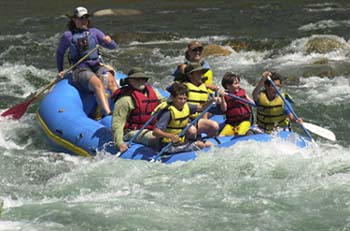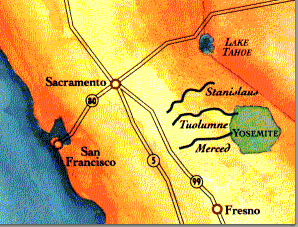 It’s a simple as this: this area of California offers the best concentration of the best whitewater rafting rafting in North America. How’s that for a blanket statement? It’s true, though, and rafting aficionados are well aware of the fact.
It’s a simple as this: this area of California offers the best concentration of the best whitewater rafting rafting in North America. How’s that for a blanket statement? It’s true, though, and rafting aficionados are well aware of the fact.
The Merced, Stanislaus and the Tuolumne Rivers are ground zero for adventures guaranteed to be wet and wild. A reminder though: this adventure is seasonal (late spring through summer) and dependent upon weather conditions with melting snow — the “force that feeds” this sport.
Here’s a river-by-river synopsis:
- Tuolumne RiverFresh from the headwaters in Yosemite National Park, the Tuolumne is the “champagne of California whitewater” and is a true wilderness experience. This Class IV+ adventure includes an 18-mile run through a rugged boulder-strewn canyon rife with wild, memorable rapids with names like Sunderland’s Chute, Grey’s Grindstone, Hell’s Kitchen and the infamous Clavey Falls, an almighty Class V drop that even prudent souls may choose to bypass.
The Tuolumne flows where no roads or other signs of civilization penetrate. Prepare yourself for pristine beaches, side-canyon water slides and swimming holes, ancient Miwok Indian campsites, bald eagles, peregrine falcons, river otters and those amazing rapids. No wonder when Congress bestowed National Wild & Scenic River Status on the Tuolumne in 1984, it was described as “the most significant victory in the history of the Wild & Scenic Rivers System.”

- Cherry Creek/Upper Tuolumne RiverThe “Cherry Creek” designation is misleading. When one thinks of “creek,” images of a slow, meandering stream come to mind. Think again. This 9-mile run (one mile of Cherry Creek and eight miles of the Upper Tuolumne) is considered by experts the “Mount Everest of rafting” … the most relentless and challenging stretch of regularly rafting whitewater in North America. With a mind-boggling 100-feet-per-mile average gradient, “the Creek” delivers nearly continuous Class IV+, V & V+ rapids and waterfalls. Only for experts, this isn’t the “creek” we used to catch crawdads in.
- Stanislaus RiverOnce one of the great whitewater rafting rivers on the West, we lost long stretches of the Stanislaus to the New Melones Dam in 1982. Some runs around Goodwin Canyon may be available, depending upon water releases subject to the whims of the Army Corps of Engineers.
Sections of the Stanislaus below New Melones (from Knights Ferry to Oakdale) offer nice float trips and some rapids. Now out of the mountains and the foothills, temperatures here in the Central Valley easily climb to above 100 degrees Farenheit in the summer and, on an August afternoon, it’s not unusual to see hundreds of boaters, rafters & tubers seeking relief from the searing summer heat.
- Merced RiverThe Merced is perhaps the best one-day, Class IV spring run in California. The typical put-in spot is near El Portal, just west of Yosemite National Park. During the typical high water of May and early june, this is an exception piece of wild water … mile after mile. When the flow ebbs in late June and July, the Merced becomes a Class III but still a thrill a minute. During high water periods, wetsuits are ofttimes required apparel.
East of El Portal, meanwhile, is another, mellower Merced River — inside Yosemite National Park. In Yosemite Valley, the Merced River is a “family affair” — typically in June and July — but it depends on water levels and temperature. Park rules hold forth here and rafting is not permitted whenever the river depth reads 6.5 feet or higher and the sum of air and water temperature is less than 100 degrees Farenheit. You must have a personal flotation device immediately available for each occupant of the raft. Rafting is permitted between Stoneman Bridge (near Curry Village) and the Sentinel Beach Picnic Area between 10am & 6pm. Visitors can rent a raft or bring your own. Other non-motorized vessels, including kayaks, are also permitted on the park’s Merced River. Kayaking is also popular on the calm waters of Tenaya Lake.
- An Important Note:
 Whitewater rafting is a blast — it provides more fun than the law should allow. Seriously though, if you’re new to the sport: beware. Know your abilities and your limits.
Whitewater rafting is a blast — it provides more fun than the law should allow. Seriously though, if you’re new to the sport: beware. Know your abilities and your limits.
Know, too, that river conditions change from year to year and from the beginning of the season to the end. Beware that cold water (and its resultant hypothermia) can quickly suck the strength from even the hardiest of souls.
As we said at the beginning, Yosemite/ Gold Country offers lots of rafting choices with adventures ranging from mellow float trips to Class V+ rapids. Families with children should opt for the safer confines of the Merced inside Yosemite or on the Stanislaus below Knights Ferry. Floatation devices are an absolute necessity for everyone in your party.
Class V+ rapids don’t guarantee a better time either — especially if you don’t make it back! Cherry Creek, for example, should be attempted only by fit, rugged men and women with strong swimming ability, excellent health and previous Class V experience.
Regardless of your choice, we strongly recommend that you use a licensed rafting outfitter like Zephyr Whitewater Expeditions that can provide the equipment and the expertise (including guides & bus portage) to maximize your adventure.
